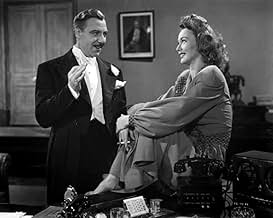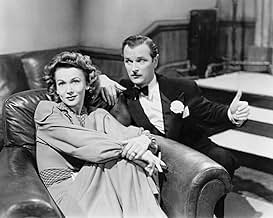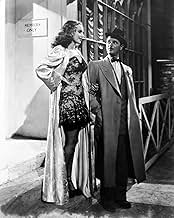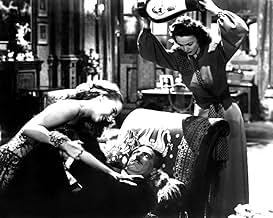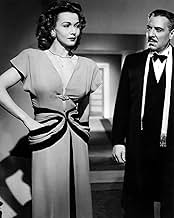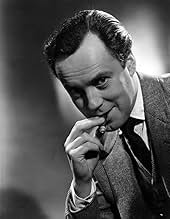Füge eine Handlung in deiner Sprache hinzuIn post- WW2 Britain, an American fashion journalist, her ex-army fiancé, and a gang of honest toughs from a local gym attempt to bring black market organized crime to justice.In post- WW2 Britain, an American fashion journalist, her ex-army fiancé, and a gang of honest toughs from a local gym attempt to bring black market organized crime to justice.In post- WW2 Britain, an American fashion journalist, her ex-army fiancé, and a gang of honest toughs from a local gym attempt to bring black market organized crime to justice.
Carol van Derman
- Mercia Lane
- (as Carol Van Derman)
Empfohlene Bewertungen
I rated this film with 6/10 mainly because the final punch-up by the boxers with the mobster gang was inconsistent, being almost comic slapstick with what had gone before involving which involved killings.As is commonly known Carole Landis had been a girlfriend of Rex Harrison and possibly through blighted affection committed suicide the same year as this film aged 29.Nigel Patrick plays an immoral cockney spiv not so ruthless as his partner an Italian gangster played by Joseph Calleia who is prone to lapse into "Don Giovanni" by Mozart occasionally.Stanley Holloway as the detective plays his part without any of the humour found in many other of his film portrayals.Derek Farr gives an unremarkable workman-like performance as the fiancé of Carole Landis.
I was surprised to find this full length 1948 film on Youtube probably because it is in the public domain and therefore out of copyright.
I was surprised to find this full length 1948 film on Youtube probably because it is in the public domain and therefore out of copyright.
Joseph Calleia and Nigel Patrick have built up a massive and occasionally underworld organization. When one of their murders comes to the attention of reporter Carole Landis, she begins a series of newspaper articles. Their increasingly threatening reaction does not faze her, but it leads her boyfriend, Derek Farr, into organizing an armed rebellion. In the meantime, slogging police inspector Stanley Holloway is closing in from his own end.
The script is by Richard Llewellyn, based on his stage play. It's been properly opened up for the screen. The problem is that it's shifting tone, from comedy to drama, never quite works. Joseph Calleia, fine actor that he is, is saddled with a heavy accent and tries to be simultaneously funny and terrifying. Patrick's character spends a lot of time as a fast-talking Cockney, more interested in performing his comedy bits on the telephone, until he decides to suddenly take matters into his own hands and take charge.
The result is a movie that is never quite sure what it wants to be, and tries to distract the audience from that uncertainty.
The script is by Richard Llewellyn, based on his stage play. It's been properly opened up for the screen. The problem is that it's shifting tone, from comedy to drama, never quite works. Joseph Calleia, fine actor that he is, is saddled with a heavy accent and tries to be simultaneously funny and terrifying. Patrick's character spends a lot of time as a fast-talking Cockney, more interested in performing his comedy bits on the telephone, until he decides to suddenly take matters into his own hands and take charge.
The result is a movie that is never quite sure what it wants to be, and tries to distract the audience from that uncertainty.
The Silk Noose, or Noose, as it is also known, from 1948 is a British film starring Carole Landis as a fashion writer for a newspaper.
It's post-war Britain, and despite the war being over, there are many items that are hard to get. An Italian black market racketeer, Sugiani (Calleia) runs an operation in black market goods. So far, the police haven't been able to get them.
A fashion writer, Linda Medbury (Landis), is determined to bring down the gang, although her publisher would rather she stick to clothes. The front for the group, The Blue Moon Club, winds up with a corpse, which sends Linda's reporter tentacles high.
Linda finds herself in danger as does her source. Her fiance is determined to protect her and bring down Sugiani at the same time. It won't be easy.
Sometimes this film seemed like a comedy, particularly with the rapid fire dialogue of Nigel Patrick as a cohort of Sugiani's, and a woman losing her dress toward the end of the film. The last twenty or so minutes has a lot of action.
This was the beautiful Landis' second-last film. What a waste of talent. She gives a vivacious, likeable performance here. Unfortunately, her career fell on hard times when she ended her relationship with Darryl F. Zanuck. Unhappy with her career and misguided in her search for love, she committed suicide. Life in Hollywood for a woman was always extremely difficult, and she was one of its victims.
It's post-war Britain, and despite the war being over, there are many items that are hard to get. An Italian black market racketeer, Sugiani (Calleia) runs an operation in black market goods. So far, the police haven't been able to get them.
A fashion writer, Linda Medbury (Landis), is determined to bring down the gang, although her publisher would rather she stick to clothes. The front for the group, The Blue Moon Club, winds up with a corpse, which sends Linda's reporter tentacles high.
Linda finds herself in danger as does her source. Her fiance is determined to protect her and bring down Sugiani at the same time. It won't be easy.
Sometimes this film seemed like a comedy, particularly with the rapid fire dialogue of Nigel Patrick as a cohort of Sugiani's, and a woman losing her dress toward the end of the film. The last twenty or so minutes has a lot of action.
This was the beautiful Landis' second-last film. What a waste of talent. She gives a vivacious, likeable performance here. Unfortunately, her career fell on hard times when she ended her relationship with Darryl F. Zanuck. Unhappy with her career and misguided in her search for love, she committed suicide. Life in Hollywood for a woman was always extremely difficult, and she was one of its victims.
Although visiting American actress Carole Landis gets top billing in the 1948 British crime thriller, "The Silk Noose" (AKA "The Noose"), it's the much underrated English actor, Nigel Patrick ("The League of Gentlemen," "The Sound Barrier," "Raintree County") who steals this movie.
From his very first appearance yelping cheerful insults into a telephone, Nigel Patrick takes command of this unusual British crime feature, as a flip and glib Cockney gangster who is part conniving Phil Silvers (think "Sgt. Bilko"), part sleazy Michael Palin (think suavely snide East End hoodlum Luigi Vercotti in "Monty Python"), and part fast-talking James Cagney (think "One, Two, Three") .
So wacky and so unexpected and so hilarious is Patrick's maniacal insincerity that you may drum your fingers impatiently during the few scenes that he's not on camera being cheerfully devious -- however action-packed some of those scenes may be. (There is considerable action in "The Silk Noose," some of it nail-biting -- this, after all, is a near-noir crime story with an alarming body count -- but on the whole it's comic-book roughhousing, best captioned by "Pow!" " Bam!" and "Oomph!")
Written by Richard Llewellyn ("How Green Was My Valley," "None But the Lonely Heart"), "The Silk Noose" homes in on "spivs," British racketeers of the late 1940s , grown fat on wartime black market profits, and now still doing their bit for Britain by blithely counterfeiting, smuggling, and, for all we know, loitering and littering. (It may take you back to Jules Dassin's more earnest, better-known "Night and the City," with Richard Widmark, which came along two years later.)
In this particular case, the local don, Sugiani (Joseph Calleia), prefers to perform his perfidy out of a posh Soho nightclub that features très chic chanteuses and très cher champagne. Looking like a Satanic Cesar Romero, Maltese-American actor Joseph Calleia cheerfully overacts, shaking his part until it cries "Basta!" Both sinister and jovial at the same time, Calleia's gangster could be seen as a stand-in for Mussolini – posturing, threatening and begging for adoration simultaneously.
Make no mistake, for all his charm and over-the-top grand opera posturing, Sugiani can be a very dangerous man, particularly when issuing orders to his very own Heinrich Himmler, a spine-chilling personal assassin known as "Barber" (the great Dickensian character actor, Hay Petrie), an unctuous, leering Claude Rains-clone who scuttles around a bleak London like a human cockroach, using a silk stocking ("the noose") as his preferred means of dispatch.
Nigel Patrick's Bar Gorman is Sugiani's right-hand man and/or partner. He could also be a stand-in for Nazi propaganda minister Joseph Goebbels, particularly when barking orders over his huge desktop intercom or trying to wheedle favorable newspaper publicity. The relationship of the two crooks is complicated, and at times the two suddenly snarl at each other like strange dogs passing on the street, then as quickly make up. It's an insane partnership made in Hell, and the two men, continuously on edge, are a fascinating team, blending affinity, iniquity and irrationality.
Into this hidey-hole of Axis-style moray eels merrily steps the Dior-dressed figure of Carole Landis, an American fashion editor working for a London newspaper (don't ask). Dressed to the nines in every shot, Landis, as a brash and beautiful career girl, puts across a delightful sassiness as she investigates a grisly London murder that isn't getting the attention she feels it deserves.
As expected, the trail leads to the bad, bad Sugiani, but, surrounded by his thuggish hirelings, he's apparently invulnerable. However, in a twist reminiscent of the creepy Peter Lorre classic, "M", the muscle-bound laborers of London's docks and markets are enrolled in a vigilante lynch mob, the lumpenproletariat out to take back their streets, and a rousing if unconvincing version of class warfare breaks out as the forces of Good, wearing football jerseys, battle the forces of Evil, in dinner jackets.
With all this, "The Silk Noose" would still be just another dated British "spiv" movie -- though with a few comedic grace notes -- but for Nigel Patrick's virtuoso performance and these three significant particulars :
1. Stanley Holloway, the beloved Alfred P. Doolittle of "My Fair Lady," plays a very well-dressed Scotland Yard inspector who may be on the take, and does it up well. He has a surprisingly commanding presence as a top cop and uses his authoritative voice to get your attention and hold it.
2. The director was Edmond Gréville, who had apprenticed with the legendary Frenchman Abel Gance ("Napoleon") . Besides pacing the movie with fast rhythmic editing, he offers up a boutique of superimposed images, extreme close-ups, artistic camera angles and surprising staging, so you don't dare blink for missing some exciting shot or experimental exposure. (For instance, he shoots one nightclub scene through the multifaceted glass top of a perfume bottle -- giving it the vertiginous viewpoint of a drunken housefly.) There's also an unexpected degree of eroticism, which marked many of the films of this half-French half-British director.
3. "The Silk Noose" was to be the next-to-the-last movie of the tragic Carole Landis, who had died by the time of the film's release in August 1948. A delightful actress with unrealized potential, she had worn herself out with endless USO tours: she had traveled more than 100,000 miles during the war, had spent more time visiting troops than any other actress, and had even caught a nasty case of malaria. By the time she killed herself at the age of 29, she had been married five times. Under still mysterious circumstances, her body was discovered by her married boyfriend, actor Rex Harrison , who, almost two decades later, was to appear with Stanley Holloway in " My Fair Lady", a triumph for them both.
From his very first appearance yelping cheerful insults into a telephone, Nigel Patrick takes command of this unusual British crime feature, as a flip and glib Cockney gangster who is part conniving Phil Silvers (think "Sgt. Bilko"), part sleazy Michael Palin (think suavely snide East End hoodlum Luigi Vercotti in "Monty Python"), and part fast-talking James Cagney (think "One, Two, Three") .
So wacky and so unexpected and so hilarious is Patrick's maniacal insincerity that you may drum your fingers impatiently during the few scenes that he's not on camera being cheerfully devious -- however action-packed some of those scenes may be. (There is considerable action in "The Silk Noose," some of it nail-biting -- this, after all, is a near-noir crime story with an alarming body count -- but on the whole it's comic-book roughhousing, best captioned by "Pow!" " Bam!" and "Oomph!")
Written by Richard Llewellyn ("How Green Was My Valley," "None But the Lonely Heart"), "The Silk Noose" homes in on "spivs," British racketeers of the late 1940s , grown fat on wartime black market profits, and now still doing their bit for Britain by blithely counterfeiting, smuggling, and, for all we know, loitering and littering. (It may take you back to Jules Dassin's more earnest, better-known "Night and the City," with Richard Widmark, which came along two years later.)
In this particular case, the local don, Sugiani (Joseph Calleia), prefers to perform his perfidy out of a posh Soho nightclub that features très chic chanteuses and très cher champagne. Looking like a Satanic Cesar Romero, Maltese-American actor Joseph Calleia cheerfully overacts, shaking his part until it cries "Basta!" Both sinister and jovial at the same time, Calleia's gangster could be seen as a stand-in for Mussolini – posturing, threatening and begging for adoration simultaneously.
Make no mistake, for all his charm and over-the-top grand opera posturing, Sugiani can be a very dangerous man, particularly when issuing orders to his very own Heinrich Himmler, a spine-chilling personal assassin known as "Barber" (the great Dickensian character actor, Hay Petrie), an unctuous, leering Claude Rains-clone who scuttles around a bleak London like a human cockroach, using a silk stocking ("the noose") as his preferred means of dispatch.
Nigel Patrick's Bar Gorman is Sugiani's right-hand man and/or partner. He could also be a stand-in for Nazi propaganda minister Joseph Goebbels, particularly when barking orders over his huge desktop intercom or trying to wheedle favorable newspaper publicity. The relationship of the two crooks is complicated, and at times the two suddenly snarl at each other like strange dogs passing on the street, then as quickly make up. It's an insane partnership made in Hell, and the two men, continuously on edge, are a fascinating team, blending affinity, iniquity and irrationality.
Into this hidey-hole of Axis-style moray eels merrily steps the Dior-dressed figure of Carole Landis, an American fashion editor working for a London newspaper (don't ask). Dressed to the nines in every shot, Landis, as a brash and beautiful career girl, puts across a delightful sassiness as she investigates a grisly London murder that isn't getting the attention she feels it deserves.
As expected, the trail leads to the bad, bad Sugiani, but, surrounded by his thuggish hirelings, he's apparently invulnerable. However, in a twist reminiscent of the creepy Peter Lorre classic, "M", the muscle-bound laborers of London's docks and markets are enrolled in a vigilante lynch mob, the lumpenproletariat out to take back their streets, and a rousing if unconvincing version of class warfare breaks out as the forces of Good, wearing football jerseys, battle the forces of Evil, in dinner jackets.
With all this, "The Silk Noose" would still be just another dated British "spiv" movie -- though with a few comedic grace notes -- but for Nigel Patrick's virtuoso performance and these three significant particulars :
1. Stanley Holloway, the beloved Alfred P. Doolittle of "My Fair Lady," plays a very well-dressed Scotland Yard inspector who may be on the take, and does it up well. He has a surprisingly commanding presence as a top cop and uses his authoritative voice to get your attention and hold it.
2. The director was Edmond Gréville, who had apprenticed with the legendary Frenchman Abel Gance ("Napoleon") . Besides pacing the movie with fast rhythmic editing, he offers up a boutique of superimposed images, extreme close-ups, artistic camera angles and surprising staging, so you don't dare blink for missing some exciting shot or experimental exposure. (For instance, he shoots one nightclub scene through the multifaceted glass top of a perfume bottle -- giving it the vertiginous viewpoint of a drunken housefly.) There's also an unexpected degree of eroticism, which marked many of the films of this half-French half-British director.
3. "The Silk Noose" was to be the next-to-the-last movie of the tragic Carole Landis, who had died by the time of the film's release in August 1948. A delightful actress with unrealized potential, she had worn herself out with endless USO tours: she had traveled more than 100,000 miles during the war, had spent more time visiting troops than any other actress, and had even caught a nasty case of malaria. By the time she killed herself at the age of 29, she had been married five times. Under still mysterious circumstances, her body was discovered by her married boyfriend, actor Rex Harrison , who, almost two decades later, was to appear with Stanley Holloway in " My Fair Lady", a triumph for them both.
Edmond Greville brought a gallic sensibility to this vivid evocation of the postwar days when Soho was a byword for criminality and vice, fluidly photographed by Hone Glendinning and ending in a slam-bang finale.
Obligatory American imports Joseph Calleia and Carole Landis both give excellent accounts of themselves as "the nastiest thug in Europe" and his nemesis "the best fashion editor in the business". A uniformly memorable supporting cast include Nigel Patrick in full-on spiv mode, John Salew as Patrick's perspiring courier rejoicing in the name 'Greasy', and Hay Petrie in his creepiest role since he played Quilp as a murderous henchman known only as 'The Barber'.
Obligatory American imports Joseph Calleia and Carole Landis both give excellent accounts of themselves as "the nastiest thug in Europe" and his nemesis "the best fashion editor in the business". A uniformly memorable supporting cast include Nigel Patrick in full-on spiv mode, John Salew as Patrick's perspiring courier rejoicing in the name 'Greasy', and Hay Petrie in his creepiest role since he played Quilp as a murderous henchman known only as 'The Barber'.
Wusstest du schon
- Wissenswertes"Noose" was filmed in England during January and February of 1948. This was the final movie Carole Landis made before her death.
- VerbindungenFeatured in Voyage à travers le cinéma français (2016)
- SoundtracksWhen Love Has Passed You By
Composed by Edward Dryhurst
Lyrics by Barry Gray and Jean Cavall
Performed by Olive Lucius (uncredited)
Top-Auswahl
Melde dich zum Bewerten an und greife auf die Watchlist für personalisierte Empfehlungen zu.
Details
- Erscheinungsdatum
- Herkunftsland
- Sprachen
- Auch bekannt als
- The Silk Noose
- Drehorte
- Warner Brothers First National Studios, Teddington Studios, Teddington, Middlesex, England, Vereinigtes Königreich(studio: made at Warner Bros. First National Studios, Teddington, England.)
- Produktionsfirmen
- Weitere beteiligte Unternehmen bei IMDbPro anzeigen
- Laufzeit1 Stunde 30 Minuten
- Farbe
- Seitenverhältnis
- 1.37 : 1
Zu dieser Seite beitragen
Bearbeitung vorschlagen oder fehlenden Inhalt hinzufügen

Oberste Lücke
By what name was Die seidene Schlinge (1948) officially released in Canada in English?
Antwort
